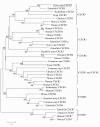The first non-mammalian CXCR5 in a teleost fish: molecular cloning and expression analysis in grass carp (Ctenopharyngodon idella)
- PMID: 20504365
- PMCID: PMC2889864
- DOI: 10.1186/1471-2172-11-25
The first non-mammalian CXCR5 in a teleost fish: molecular cloning and expression analysis in grass carp (Ctenopharyngodon idella)
Abstract
Background: Chemokines, a group of small and structurally related proteins, mediate chemotaxis of various cell types via chemokine receptors. In mammals, seven different CXC chemokine receptors denoted as CXCR1 to CXCR7 have been reported. However, the chemokine receptor CXCR5 has not been reported in other vertebrates.
Results: In the present study, the genomic sequence of CXCR5 was isolated from the grass carp Ctenopharyngodon idella. The cDNA sequence of grass carp CXCR5 (gcCXCR5) consists of 1518 bp with a 43 bp 5' untranslated region (UTR) and a 332 bp 3' UTR, with an open reading frame of 1143 bp encoding 381 amino acids which are predicted to have seven transmembrane helices. The characteristic residues (DRYLAIVHA) and conserved cysteine residues are located in the extracellular regions and in the third to seventh transmembrane domains. The deduced amino acid sequence shows 37.6-66.6% identities with CXCR5 of mammals, avian and other fish species. The grass carp gene consists of two exons, with one intervening intron, spaced over 2081 bp of genomic sequence. Phylogenetic analysis clearly demonstrated that the gcCXCR5 is clustered with those in other teleost fish and then in chicken and mammals. Real-time PCR analysis showed that gcCXCR5 was expressed in all tested organs/tissues and its expression level was the highest in trunk kidney, followed by in the spleen. The expression of gcCXCR5 was significantly modulated by immunostimulants such as peptidoglycan (PGN), lipopolysaccharide (LPS), polyinosinic-polycytidylic acid sodium salt (Poly I:C) and phytohaemagglutinin (PHA).
Conclusion: The cDNA and genomic sequences of CXCR5 have been successfully characterized in a teleost fish, the grass carp. The CXCR5 has in general a constitutive expression in organs/tissues examined, whereas its expression was significantly up-regulated in immune organs and down-regulated in brain, indicating its potential role in immune response and central nervous system.
Figures





References
-
- Struyf S, Proost P, Van Damme J. Regulation of the immune response by the interaction of chemokines and proteases. Adv Immunol. 2003;81:1–44. full_text. - PubMed
Publication types
MeSH terms
Substances
Associated data
- Actions
LinkOut - more resources
Full Text Sources
Research Materials

